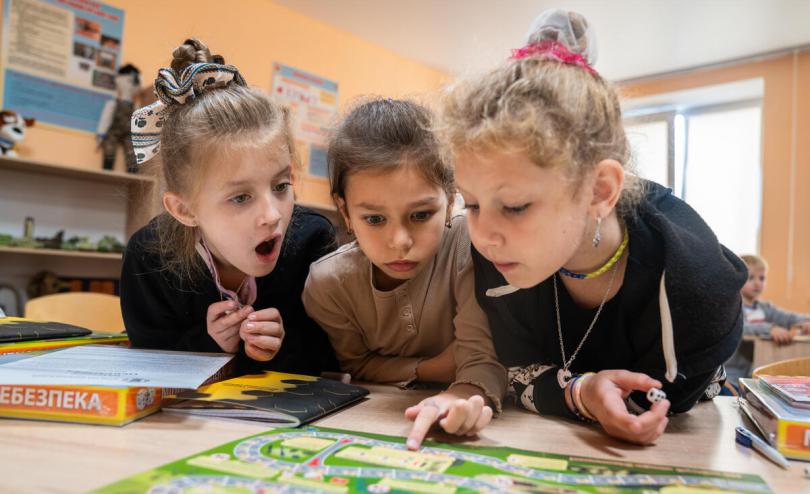UKRAINE: Save the Children boardgame shows children how to avoid mine dangers

Girls play the Mine Danger board game during a mine awareness session in Kyiv region, Ukraine. Credit Oleksandr Khomenko/Save the Children
KYIV, 18 December 2023 – Steer clear of bare ground. Do not go near abandoned tanks. Never reach for a discarded toy. Call the emergency services.
Children in Ukraine who are terrified to step on the ground due to the high prevalence of land mines or explosive remnants of war are being taught how to stay safe – using a board game developed by a Save the Children partner. Players take turns rolling a dice to advance on the board, while learning how to avoid danger and what rules to follow.
Over 6,000 copies of the “Mine Danger” game have been distributed to children in the north and south of Ukraine. Along with the game, Save the Children also facilitates mine risk awareness classes. More than 17,000 children, parents, caregivers, and community members are expected to attend mine-risk awareness training by the end 2023.
Ira*, 7, and Vika*, 8, primary school students from Kyiv region who attend the training, said:
“I learned how to know where they [mines] are even without a sign. If you see a weird toy, you should not approach it and move away. Also, if you see a tank or any destroyed machinery, you cannot go there. And if there is bare ground where nothing grows, you cannot go there either.”
Landmine education is proving critical for the safety of children in Ukraine, where at least 1,068 people have been killed or injured by mines or explosive remnants of war since the start of the war – the equivalent of two every day since February 2022.
In less than two years, Ukraine has become the most heavily mined country in the world. Up to one third of Ukrainian territory - or 174,000 square kms which is equal to the size of Florida in the US – is contaminated. Even areas where active fighting has ceased remain gravely dangerous due to the high prevalence of landmines and unexploded ordnance.
Areas near the frontline in the east and south of the country are particularly affected.
In a town just 70km (43 miles) from the fighting in Kharkiv region, Illia* , 7, used to be so terrified of mines that he refused to step on the ground.
Illia’s* family endured five weeks of relentless fighting and shelling at the start of the war.. Their home was damaged by a shockwave from an explosion and several mines landed in their backyard.
“I opened the door and mines started flying above. Two fell in our backyard, five or six in the neighbour’s garden. It was a direct hit to the house. If it were not for the snow, the house would have burned down.It was scary, especially when cluster munitions started flying,” Illia’s* father, Serhii*, said.
The experience made Illia* too scared to be alone, even for a brief time. He refused to walk outside of the home, so his parents and grandmother had to carry him wherever they went.
lllia’s* mother Antonina*, said: “Illia* was not going outside. He said someone might have planted [explosives] at night when we did not see. He would not walk in the backyard. He has only now began moving more freely but he still walks cautiously; he is not running around, and he won’t step on grass at all. He will only walk on the pavement.
“We only walk where others have gone first. I am an adult, and I am afraid.”
Just 20% of the contaminated land - about 40,000 square kms – is currently accessible for de-mining due to ongoing hostilities, according to the government of Ukraine. Research suggests it might take up to 757 years and $37 billion to clear the land.
Sonia Khush, Country Director for Save the Children in Ukraine, said:
“After almost two years of war, mine contamination in Ukraine has reached terrifying proportions and is only growing by the day. Even in areas without active conflict, children and their families are in grave danger of coming across an explosive object. The risk of sustaining life-changing or terminal injuries for children is extremely high; they are seven times more likely to die because of blast trauma.
“The life of a child should be carefree, playing in a safe environment without worrying about every step they take. Unfortunately, children living in the conflict-affected areas of Ukraine have been robbed of what others take for granted.”
Save the Children calls on all parties to refrain from the use of explosive weapons with wide area effects in populated areas and take stock of the impact on civilian populations in the planning and conduct of military activities. Mines and other explosive ordinances pose a serious risk to children and hamper possibilities of development of those mine affected areas.
Save the Children has been working in Ukraine since 2014 and has scaled up operations since the war escalated in February 2022. The organisation is working closely with multiple partners to provide life-saving assistance such as food and water, cash transfers, and safe spaces, to make sure children and families impacted by this crisis have the support they need.
END
*names changed to protect identity
For more information please contact:
- Vsevolod Prokofiev Vsevolod.Prokofiev@savethechildren.org (based in Kyiv)
- Anna Rauhanen Anna.Rauhanen@savethechildren.org (based in London)
- Our media out of hours (BST) contact is media@savethechildren.org.uk / +44(0)7831 650409
Please also check our Twitter account @Save_GlobalNews for news alerts, quotes, statements and location Vlogs.
Multimedia content available https://www.contenthubsavethechildren.org/Package/2O4C2S3LM2QT




